Leah Penniman is an American anomaly: black, female, and a farmer. In 2016, Penniman hit the streets of Albany, New York, to protest the police brutality that killed Donald “Dontay” Ivy, 39, an unarmed local man. But her primary focus involves fighting what she considers a far more common, yet more subtly brutal, form of oppression. “Corporations, and white folks in particular, control the food system,” explains the 37-year-old. “If the means of production are in the hands of people outside our community, we are dependent on those who might not have our best interests in mind.”
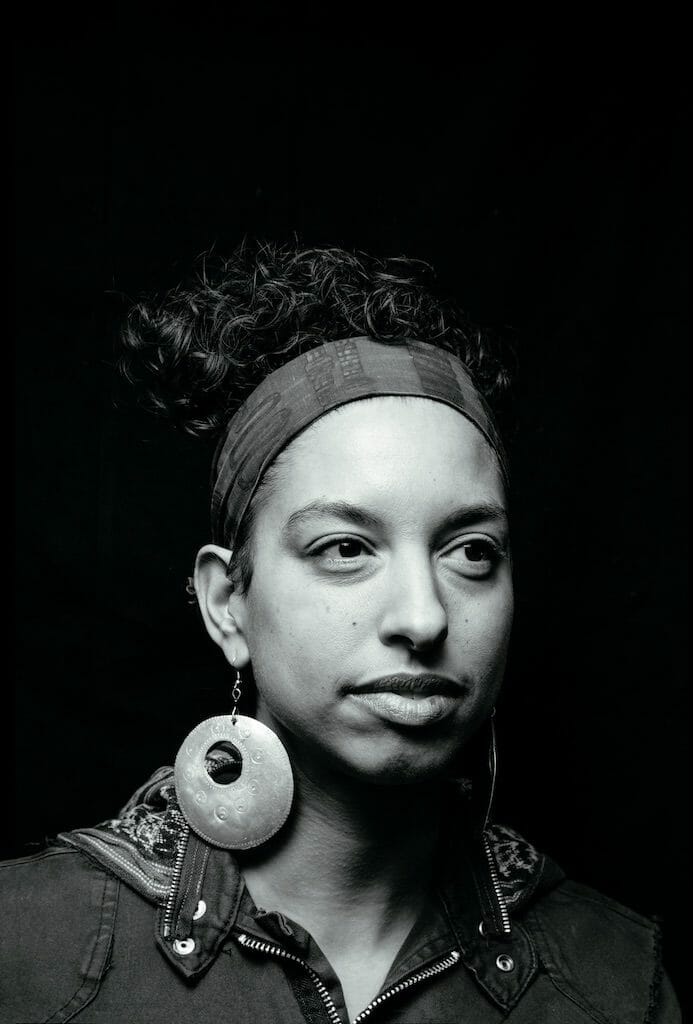
An alarming series of stats bears out her logic: Heart disease, type 2 diabetes, and other potentially fatal diet-related illnesses afflict African Americans at nearly twice the rate they do Caucasians. Black people are four times less likely than white ones to live within a mile or two of a supermarket, while predominantly black neighborhoods boast 13 times as many fast-food billboards. The polite euphemism for this specific facet of institutionalized racism is “food desert.” Penniman prefers the term “food apartheid.” “I’ve experienced first-hand how difficult it is to live in a place where you have to hustle for vegetables,” says the mother of two.
Twelve years ago, Penniman was working as a biology teacher at Harriet Tubman Democratic High School in Albany’s low-income South End district when she and her husband, Jonah Vitale-Wolff, 38, acquired 72 acres in nearby Grafton. From the get-go, the couple’s Soul Fire Farm has operated on a sliding-scale CSA model that encourages affluent customers to subsidize boxes of organically grown produce and pastured chickens for less fortunate capital-region residents. The initial goal, as Penniman defines it: “We wanted, straight up, to deliver fresh, high-quality food to our people at prices they could afford.”
Since then, the farm’s mission has expanded to include the cultivation of fellow entrepreneurs of color. In 2012, Soul Fire hosted its inaugural Black-Latinx Farmers Immersion, an intensive week-long course that consists of lessons devoted to amending soil and slaughtering chickens, plus yoga and drum circles. “This is a culturally relevant celebratory space. There is movement and singing. We have mad fun,” Penniman says. “Still, the endgame remains land and food sovereignty for disenfranchised populations.” So far, the course claims 347 graduates, 83 percent of whom are currently farming, involved in other food-related businesses and organizations, or growing their own food. A total of 100 new acolytes will attend five sessions scheduled for this summer and fall.
“When I went to buy my first tractor, the gentleman behind the counter said,’what the hell are you going to do with a tractor?’” recalls Renard “Azibo” Turner. “The structural racism was so deep in him that he couldn’t take me seriously as a black farmer.”
In 2013, Penniman struck a deal with the Albany County District Attorney’s office, allowing area youth to abbreviate their juvenile detention sentences, and earn food for their families, by logging time at Soul Fire. “Black and brown children, many arrested as young as 11 for skipping school or petty theft, find themselves trapped in a downward spiral of incarceration,” she laments. “We’re countering that narrative with hope.” Beyond the oft-cited “healing power of the soil,” this arrangement grants kids access to hip role models who represent an alternative path.
And three years ago, Penniman launched “Uprooting Racism in the Food System,” a four-day workshop she describes as “training to de-program white people in positions of power or influence – someone who might hold public office or direct a nonprofit.” Or, perhaps, write for a national magazine. This is the point at which I should admit to being a white man, albeit one steeped in issues of class and race since birth. I grew up in a poor, black part of Atlanta, the son of civil rights activists and the grandson of a woman who represented Harlem in New York’s state Legislature. But even well-intentioned liberals like me, argues Penniman, can become complicit in supporting the status quo. “The workshop gets them to stop thinking of racism simply as interpersonal meanness, like using the N-word, and to recognize the ways it’s been baked into our structures.”
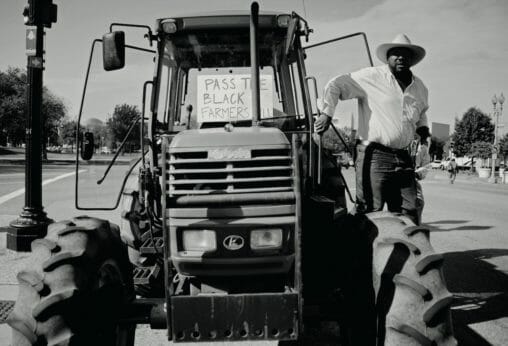
John W. Boyd Jr., 52 (pictured here with his tractor, “Justice,” in 2010), founded the National Black Farmers Association in 1995. A year later, the Virginia farmer led a march on Washington to protest the USDA’s discriminatory lending practices, spurring the agency to suspend all loan foreclosures.
Of course, the former Fulbright scholar well understands that changing a few white minds won’t solve the larger problem: “In addition to external factors, there are internal ones. Our community inherited centuries of land-based trauma. Farming is not seen as a noble profession because of its correlation with enslavement.”
It’s a condition Renard “Azibo” Turner calls “anti-agricultural blacklash.” As a child, Turner was the sole black kid in his California chapter of Future Farmers of America. Today, he raises organic vegetables and myotonic “fainting” goats for meat on 94 acres outside Charlottesville, Virginia. The 65-year-old has tried to recruit young African American farmers through his long line of leadership positions – board president of the Virginia Association for Biological Farming, national secretary of the American Kiko Goat Association, member of the USDA’s Minority Farmers Advisory Committee – with little success. “The majority of black people I encounter are not interested in doing anything agricultural because they relate it to slavery,” he says.
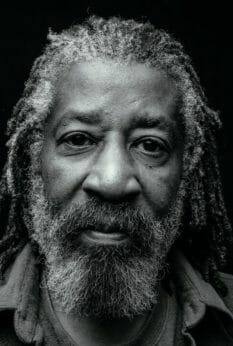
A former member of the USDA’s Minority Farmers Advisory Committee and the proprietor of Vanguard Ranch near Charlottesville, VA, Renard “Azibo” Turner believes that slavery permanently soured many African Americans on agriculture.
The white ones certainly haven’t made Turner’s lonely row any easier to hoe. “When I went to buy my first tractor, the gentleman behind the counter looked at me like I was from another planet,” he recalls. “This person says to me, ‘What the hell are you going to do with a tractor?’ The structural racism was so deep in him that he couldn’t take me seriously as a black farmer.”
Although Turner considers the proliferation of black-run urban farms a positive trend, he notes that these growers rarely hold the deed to the land they work. “I support the efforts to turn vacant lots into community gardens,” he explains, “but that’s not going to create an inheritance for generations to come. The way to achieve parity in this country is by owning a piece of the rock.”
A century ago, the demographics looked much different. In 1920, before the Great Migration drew some six million African Americans to cities such as Chicago and New York, 14 percent of the farm owners in this country were black, at a time when only 10 percent of the population was. Collectively, those one million individuals owned 15 million acres of land. Over the ensuing decades, however, these farmers left agriculture at a rate three times faster than their Caucasian counterparts, and by 1992, the percentage of U.S. farms owned by African Americans had dwindled to less than one percent.
By owning her farm, and being her own boss, Fannie Lou Hamer became impervious to the scare tactics of white employers. “She and others like her were able to take a role in the front lines of voter registration drives, were the first to sign petitions, and didn’t hesitate to speak up at NAACP meetings,” says Leah Penniman.
Obviously, black farming families had plenty of life-threatening motivation to flee the Jim Crow”“era South, but subtler forces also conspired to diminish the black land base. The county-level USDA offices that farmers relied on were notorious for giving African Americans the runaround, routinely denying or delaying loan applications for dubious reasons. A 1965 report by the Georgia State Advisory Committee to the U.S. Commission on Civil Rights cited multiple incidents of USDA agents addressing black farmers as “boy” and ultimately concluded that “negro farmers in Georgia…feel they are being phased out.” A federal office established to field, if not address, such complaints closed in 1983 because of funding cuts under President Reagan. And as recently as 1987, one of the USDA’s few African American supervisors told The Washington Post the agency was “a good-old-boy buddy system.”
Adding insult to these injuries, increasing agricultural consolidation put the squeeze on black farmers unable to access the capital necessary to scale up. By 1982, the average farm operated by a white American spanned 440 acres, more than four times the size of an average black-owned one. Black farmers couldn’t get big, so they got out – typically via foreclosure notice.
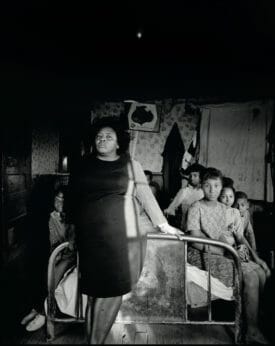
This photograph of the late civil rights activist Fannie Lou Hamer (foreground) was taken in 1970, one year after Hamer formed the Freedom Farm Cooperative in Sun ower County, MS.
Finally, in December 1996, John W. Boyd Jr., founder of the National Black Farmers Association, and approximately 50 of the organization’s members marched to the gates of the White House, protesting the USDA’s discriminatory lending practices and demanding to speak with President Clinton. Though a meeting was not forthcoming, Clinton’s secretary of agriculture, Dan Glickman, immediately suspended foreclosures on all unpaid USDA loans, pending an investigation. A year later, one of the protesters, Timothy Pigford, a corn and soybean farmer from Cumberland County, North Carolina, initiated a class action lawsuit against the USDA. Pigford v. Glickman resulted in the largest civil rights settlement in U.S. history at the time, awarding more than $1 billion to almost 16,000 African American farmers. A subsequent suit, known as Pigford II, awarded an additional $1.25 billion to 18,000 farmers in 2010.
Over the past few decades, the expanding organic sector has offered a lifeline to small farms, given that organic crops are, on average, 30 percent more profitable than conventionally grown ones. Unfortunately, Penniman and Turner are among the few African American farmers taking advantage of this fact. “People of color have been woefully underrepresented in the organic arena,” says Owusu Bandele, a professor emeritus of plant and soil sciences at Southern University in Baton Rouge, Louisiana, who established Food For Thought Farm, the first black-owned certified-organic operation in the state.
In 2007, Bandele, 75, co-founded the Southeastern African American Farmers’ Organic Network, which helps black farmers in the region navigate the organic certi cation process and grants minor loans, as well as other forms of assistance. The organization, headquartered in Atlanta, currently counts 50-plus black-owned certified-organic farms among its ranks. “The possibilities, both ecologically and economically, are truly exciting,” he says.
Organic crops are, on average, 30 percent more profitable than conventionally grown ones. Unfortunately, says Owusu Bandele: “people of color have been woefully underrepresented in the organic arena.”
This tendency of African American farmers to empower one another has deep historical underpinnings, says Penniman, pointing to the example of famed civil rights activist Fannie Lou Hamer. A sharecropper evicted for registering to vote in 1962, Hamer raised enough capital to gradually establish the 680-acre Freedom Farm Cooperative in Sunflower County, Mississippi, a refuge of sorts for evicted tenant farmers. By owning the land, and being her own boss, Hamer became impervious to the scare tactics of white employers: “She and others like her were able to take a role in the front lines of voter registration drives, were the first to sign petitions, and didn’t hesitate to speak up at NAACP meetings.”
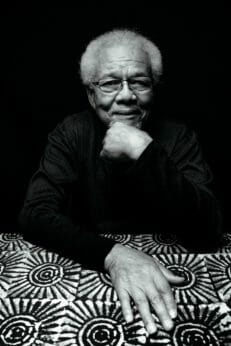
Owusu Bandele is a professor emeritus of plant and soil sciences at Southern University, a historically black land-grant institution in Baton Rouge, LA, and the founder of the state’s first African American”“owned certified-organic farm, the aptly named Food For Thought. In 2007, Bandele helped launch the Southeastern African American Farmers’ Organic Network.
Penniman is adding her own line to that proud story, providing a place where farmers of color won’t be regarded with suspicion in rural upstate New York. “Sometimes, there’s a shoot-first, ask-later mentality around here,” she admits, “but we’re working hard to build relationships with our white neighbors.” Meanwhile, Soul Fire’s “Uprooting Racism in the Food System” course is already yielding fruit. A white graduate recently called to say he’d decided to deed property to an African American group interested in farming. “Reparations,” Penniman says. “Now that’s powerful.”
Editor’s Note: Leah Penniman is the author of the forthcoming book Farming While Black (Chelsea Green Publishing), which will be out in November 2018. Pre-order it now at Amazon.com.
We also have to consider the original Native American Aborigines or American Indians.
A few million of us STILL exist among the African-American population.
As a LOT of us were dispossessed and enslaved with West Africans we became re-classified as African-American based on Skin Complexions alone.!!!
We are not originally Moors, Jews, Arabs or Caucasians but we were impacted by the migrations and intetmixtures here.
Still there are millions of us among the African-American population that still retain, promote and sustain our natural Indigenous heritage.
Yes. LAND MATTERS.!!!
just bought land and i need help
Great film re: the Gullah around the time of migration when people were deciding to leave/go to the mainland.
“Daughters of the Dust” – Julie Dash Cinematography evocative & amazing. Seen it + 8 times. As with any great film you see, you get new insights each new viewing.
Suggestion for Fundraiser
Film showing & auction of Sugarcane mounted on memorial plaque and the syrup.
– Retired college professor & “non-profit P.R. for non-profits” / Latina